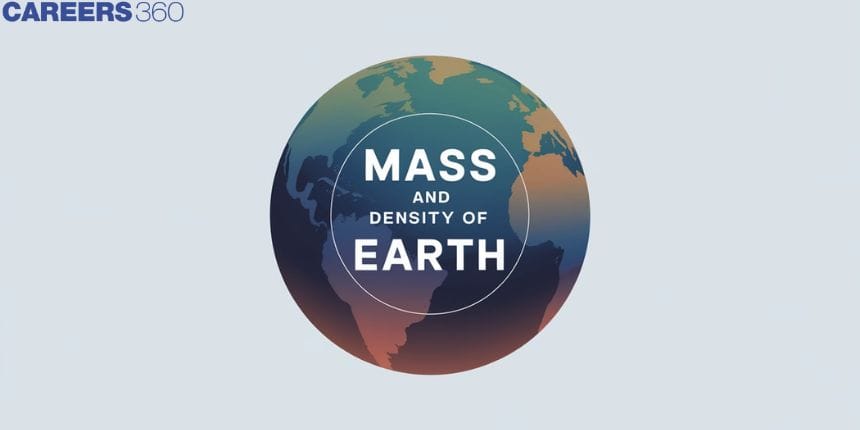Mass And Density Of Earth
Understanding the mass and density of the Earth is crucial not just for scientists, but for anyone curious about how our planet supports life. The Earth's mass determines the gravitational force that holds everything from oceans to the atmosphere in place, while its density reveals how matter is distributed throughout the planet. Imagine standing on the ground; the force you feel pulling you down is a direct result of the Earth's mass. This gravitational pull allows us to walk, build structures, and even keep our atmosphere intact. In daily life, these concepts explain why we don't float off into space or why the air we breathe remains around us. By exploring Earth's mass and density, we gain insights into the very forces that shape our world.
This Story also Contains
- What is the Mass of the Earth?
- Soρ=3g4πGRρ=5478.4 kg/m3What is Inertial Mass?
- What is Gravitational Mass?
- What is Mass (m)?
- What is Weight (W)?
- Solved Examples Based on Mass and Density of Earth
- Summary

What is the Mass of the Earth?
Using Newton’s law of gravitation we can estimate the mass of the earth
What is the Density of Earth?
Where
What is Inertial Mass?
Also known as the mass of material of the body which measures its inertia.
From Newton’s second law of motion
Gravity has no effect on inertial mass.
Inertial mass is independent of the size, shape, and state of the body.
What is Gravitational Mass?
It is mass which determines the gravitational pull acting upon it.
Let
We have
So we get
Where
Tip-Spring balance measures gravitational mass.
What is Mass (m)?
1. It is the quantity of matter contained in the body.
2. Its SI unit- Kg
3. Its dimension is
4. It is a scalar quantity.
5. It Can never be zero
6. Its value does not change with g.
What is Weight (W)?
1. It is an Attractive force exerted by the earth on anybody.
2. S.I. Unit: Newton or Kg - wt
3. Dimension-
4. It is a vector quantity
5. It changes its value according to the value of
6. At
Recommended Topic Video
Solved Examples Based on Mass and Density of Earth
Example 1: Average density of the earth
1) is directly proportional to g
2) is inversely proportional to g
3) does not depend on g
4) is a complex function of g
Solution:
Density of Earth
wherein
Hence, the answer is the option 1.
Example 2: Which one statement is incorrect?
1) Gravity has no effect on the inertial mass of the body.
2) Inertial mass is independent of size, and shape.
3) Inertial mass measured by spring balance.
4) It is conserved when two bodies combine physically or chemically.
Solution:
Inertial mass
Mass of material of body which measures its inertia.
Gravity does not affect inertial mass.
wherein
The inertial mass is measured by physical balance, not by spring balance.
Hence, the answer is the option 3.
Example 3: Which one statement is incorrect?
1) Gravitational mass is defined as the gravitational pull experienced by the body in the gravitational field.
2) Gravitational mass measured by spring balance
3) The dimensional formula of gravitational field intensity is
4) Gravitational mass is measured by applying Newton's law of gravitation
Solution:
Gravitational mass
wherein
Mass which determines the gravitational pull acting upon it,
If
Hence gravitational mass is defined for unit field intensity.
Hence, the answer is the option 1.
Example 4: Which one of the statements is incorrect regarding mass?
1) It is a scalar quantity
2) The value of mass does not depend on gravity
3) The mass of a body is given by
here symbol have their usual meaning.
4) mass can never be zero.
Solution:
Mass
Quantity of matter contained in the body
dimension
wherein
(i) Value does not change with g
(ii) Can never be zero
(iii) Scalar quantity
Hence, the answer is the option 3.
Example 5: Regarding weight (w) which is correct?
(i) Its value changes with g
(ii) At the centre of the earth weight is maximum
(iii) The unit is kg-wt
(iv) It is a vector quantity
1)Only (i) and (iv)
2) Only (i), (iii) and (iv)
3) Only (ii) and (iii)
4) All of the above
Solution:
Weight (W)
The attractive force exerted by the earth on anybody.
S.I. Unit: Newton or Kg - wt
Dimension
(i) Value changes with g
(ii) at
(iii) Vector quantity
At the centre of the earth,
Hence, weight
Hence, the answer is the option (2).
Summary
The Earth contains is estimated to be made up of 5.97 × 1024 kg. A big portion of this mass is iron (nearly 32%), oxygen (30%) and then silicon (15%) followed by magnesium at 14%, while the remaining make up the rest. In its core, there are high concentrations of heavy metals hence it has a high mass density, about 5.52 grams per cm3 as opposed to most planets that fall within our solar system. The reason behind its high density is that there are many heavy elements in the mantle and crust of Earth.